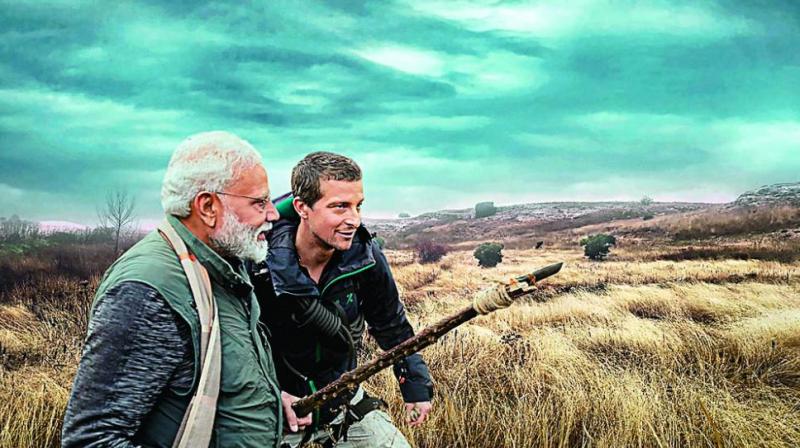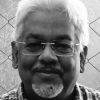Why PM Modi heard the call of the wild

In the summer of 1966, 73-year-old Mao Zedong jumped into the Yangtze River to participate in Wuhan’s annual swim. It was a carefully crafted political theatre. The official Chinese news agency reported: “The water of the river seemed to be smiling that day.”
Mao, the Chinese propaganda machinery claimed, swam 15 km along the Yangtze in 65 minutes. The Chinese leader, it seems, was swimming a mile in eight minutes while the world record at that time was under 20 minutes.
More than half a century later, on February 14 this year, Prime Minister Narendra Modi also jumped into a river flowing through the Jim Corbett National Park along with a fading reality TV star, Bear Grylls. He successfully built a makeshift raft with Grylls and managed to stay afloat — not that there was any prospect of “the most important man in India”, as Grylls refers to him, drowning. Whether the 68-year-old Indian PM also swam in the river, one does not know. But he was familiar with rivers having wrestled a crocodile as a young kid, as the apocryphal story goes.
Political observers now claim that Mao’s Yangtze swim was a profoundly significant event in modern Chinese history. When Mao entered the waters of the Yangtze at Wuhan, he was the old man of the revolution. He emerged from it reborn — ready once more for his historic role as the Great Helmsman. He used his replenished political capital to launch the Cultural Revolution and purge his rivals from the party.
In February 2019, Prime Minister Modi also seemed on shaky political grounds. The general election was around the corner, the unemployment rate was the highest in 45 years, rural distress was acute, farmers were restive, small businesses which had closed down because of his rash demonetisation decision were struggling to survive, exports were declining and manufacturing was in the doldrums. There was desperation to construct a credible re-election platform. A film on the much-hyped surgical strikes against Pakistan called Uri had just been released. And a biopic of the Prime Minister was in the offing before the general election.
That is when Bear Grylls’ call of the wild came. The Prime Minister’s managers must have grabbed it with both hands. It was unfortunate, however, that while the Prime Minister was busy in shooting a carefully scripted political documentary in the wilds, calamity struck. While the two ageing stars were trying to get brand rub-off from each other, a major terrorist attack took place at Pulwama, killing 40 paramilitary personnel.
The terrorist struck at 3.10 pm while the shooting for Man vs Wild reportedly took place between 2.30 pm and 4.30 pm. The Prime Minister did address a public meeting later that evening but made no reference to the terrorist attack. Whether India’s PM, who controls the nuclear button, could really have been incommunicado during this period is something that cannot be settled here. However, the fact is that had Pulwama not happened, the Man vs Wild episode of the Prime Minister hunting with Bear Grylls and building a raft to cross a dangerous river would have repackaged him as a youthful, robust and athletic leader ready to lead the nation again. Because the Pulwama terror attack provided the sailing boat and India’s retaliatory airstrikes on Pakistan the tail wind for the Prime Minister’s successful re-election, Bear Grylls’ little DIY raft was no longer needed.
What purpose then does screening the Man vs Wild episode serve now after the massive election victory of Prime Minister Modi? Testosterone as political capital has been the defining mantra of Prime Minister Modi’s politics. His entire electoral journey is marked by the masculinisation of political capital, where being manly is conflated with competent leadership, exuding authority and virility.
In modern times, however, Prime Minister Modi’s role model cannot be the aging Chairman Mao swimming, although the aim of political theatre at the Corbett National Park may be reminiscent of the historic plunge into the Yangtze, the role model of the PM is less likely to have been Mao than the slightly younger (66-year-old) Russian President Vladimir Putin.
The Russian President has time and again used the symbolic display of masculinity to build political authority. He truly is the master of masculine political performance in stunning visuals — saving journalists from a Siberian tiger by shooting it with a tranquillising dart, posing bare-chested on horseback in an idyllic rural setting, engaged in an energetic butterfly stroke while swimming, playing with dolphins, fishing shirtless in a river, racing around a track in a Formula One car, hurling judo opponents to the ground; and even descending oceanic depths in a mini-submarine.
Where Mr Putin has his judo, the Indian Prime Minister has yoga. Mr Putin is a 6th Dan black belt in judo, but has been awarded the 9th Dan by the World Taekwondo Federation, higher than famous US martial arts artist Chuck Norris, who is only an 8th Dan. Prime Minister Modi teaches yoga to the entire nation by videos in the run up to World Yoga Day, leaving behind the leadership of his one-time acolyte and yoga publicist Baba Ramdev.
Prime Minister Modi’s macho aura is at the centre of his attempt to push competitors out of the public sphere. It celebrates the tough guy who alone can stand up to Pakistan and terrorism, and who can keep at bay carping liberals, the “tukde-tukde gang”, “urban Naxalites” and all others who are intent on weakening the Indian nation and eroding its image nationally and internationally. Everybody else is a wimp and a pappu.
Building a personality cult, like Mr Putin, then may be part of a political legitimation strategy for Prime Minister Modi. But it could also be a part of a larger trajectory imagining himself as a man of destiny chosen by history to reclaim the dignity and respect due to India.
The Man vs Wild performance is a platform that will also bolster his image abroad. The programme after all will be telecast in 180 countries.

